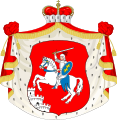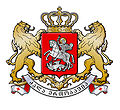Coat of arms of Lithuania
| Coat of arms of Lithuania | |
|---|---|

|
|
| Details | |
| Heraldic shield | Knight |
The coat of arms of the Republic of Lithuania bears the name Vytis ("the pursuer"), also translated as "the white knight ", and is one of the oldest European coats of arms.
The current coat of arms is laid down in Article 15 of the Lithuanian Constitution , which was adopted by referendum in 1992. The coat of arms description reads:
- “ The national coat of arms shows a white Vytis on a red field. "
description
The modern shield, adopted in September 1991, shows in red a silver knight in armor with gold spurs on a white (silver) jumping horse. In his right hand he carries a silver sword with a gold hilt over his head, in his left a blue shield with a gold Lorraine cross . The clasp of the silver scabbard of the sword is gold, the saddle and bridle of the horse are blue with gold decoration.
history
The Vytis was used by the Lithuanian prince Narimantas (son of Gediminas ) as early as the 14th century, as reported in the Chronicle of Schemeitia .
The attacking knight is officially recorded for the first time in 1366 on the seal of the Lithuanian Grand Duke Algirdas . The symbol of the attacking knight was passed on to Algirdas' son Władysław II. Jagiełło ( Jogaila in Lithuanian ) and to subsequent generations. Jogaila accepted the double cross as the alleged cross of Saint Ladislaus when he was baptized in 1386. It subsequently became the Jagiellonian family symbol and is also part of the national coats of arms of Hungary and Slovakia .
In the 14th century, Vytis was also represented in a heraldic shield, first documented in the seal Jogailas 1386 (or 1387) and in the seal Vytautas ' 1401.
As early as the 15th century, the knight in this form became the coat of arms of the Grand Duchy of Lithuania and the central Duchy of Vilnius. Older versions also show the rider with a lance and riding to the left, but in the second half of the 15th century at the latest, the sword and shield of the knight and the (heraldic) orientation are on the right, as are the colors and shape of the shield on the left Hand of the knight binding.
The name Vytis was first documented in the 16th century, but probably a lot older.
The attacking knight was originally a representation of the Lithuanian ruler, but over the centuries it was interpreted as a knight who drives attackers from his homeland. This interpretation was particularly popular in the 19th and early 20th centuries.
A historical explanation for this interpretation is a report about the Battle of Tannenberg of 1410, in which the Polish-Lithuanian armed forces stopped the expansion of the Teutonic Order eastwards. According to this report, thirty of the forty Lithuanian regiments fought under the flag of Vytis.
With minor stylistic changes, the coat of arms remained the Lithuanian state symbol until 1795 . When Poland-Lithuania was formed, the Vytis was united with the Polish eagle in the national coat of arms.
Over time, the Vytis became more and more popular and a part in the coat of arms of many provinces and cities of Lithuania. The Vytis attached to the east gate of the city fortifications of Vilnius (" Gate of Dawn "), which has survived to this day, symbolized the position of the city as the Lithuanian capital.
When Lithuania was annexed by the Russian Empire in 1795 , the Vytis was integrated into the Russian great coat of arms. It was used in a modified form for the city of Vilnius and the associated governorate .
First half of the 20th century
After Lithuania's independence, the Vytis became the official state symbol again. Numerous artists made designs for the coat of arms. The most popular version by Antanas Žmuidzinavičius showed the long, three-part saddlecloth from the coat of arms of Poland-Lithuania. However, there was no official coat of arms.
In 1929 a commission headed by the Lithuanian draftsman Mstislav Dobuzhinsky was convened to develop a state symbol from historical models from the 16th century. The proposal of this commission, which incidentally dispensed with the princely crown in the crest, was never officially accepted.
After the occupation by the Soviet Union in 1940, the Vytis was banned, the use of the symbol was punishable and could be punished with imprisonment or deportation under Josef Stalin . During the time of the Eastern Bloc there were only two publicly visible images of Vytis, namely at the "Gate of Dawn" in Vilnius and on the tiled image of the Prince's procession in Dresden under the words "Fr. August D.Gerechte" and the year "1763-1827" . The Lithuanian SSR received a coat of arms modeled on other Soviet coats of arms, which was valid until 1990.
1988-2007
It was not until 1988 that the Vytis was re-anchored in law and on March 11, 1990 it was again the country's official national symbol. The design was based on the design of the Lithuanian sculptor Juozas Zikaras from 1925, which he had designed for the Lithuanian Litas coins. This was a clear sign of the connection to the independent Lithuania of the years 1918–1940.
On April 10, 1990, the Supreme Soviet of the Republic of Lithuania officially put the state emblem back into operation and determined its use; on September 4, 1991, the design was modified according to the recommendations of a heraldry commission, using the colors of the Vytis from the historical templates became binding again.
In 2004 the Seimas introduced a state flag, which shows the national coat of arms on a red background, as it was used from 1918-1940. This flag does not replace the Lithuanian tricolor , but is hoisted by state institutions on special occasions and anniversaries. Recently, a large version of the coat of arms was also proposed, showing a banner with a verse from the Lithuanian national anthem (“ Vienybė težydi ” - “May unity flourish”).
In 2007 Vytis is planned to be anchored in the red phone as the state flag and the yellow-green-red flag to be recognized as the national flag. This would continue the traditions of Poland-Lithuania , with a view to Eastern European economic, cultural and political cooperation with Poland (in the EU ), Belarus and Ukraine as a possible common symbol.
The red flag with Vytis was not declared as the state flag after the declaration of independence in 1918 because it wanted as few associations as possible with the Bolsheviks and their 1917 revolution. In the historical and modern context, the red color would symbolize the blood that was used in the struggle for freedom of the Grand Duchy of Lithuania , the liberation movements during the uprisings of 1830–1833 and 1860–1863 in the former territory of Poland-Lithuania and the liberation movements during the Soviet occupation and should therefore be anchored in the coat of arms.
Coat of arms of the Russian governorate of Vilnius (1845)
Juozas Zikaras' design (1925)
Origin of the word Vytis
The origin of the word Vytis is not entirely clear. It is documented for the first time in 1846 by the Lithuanian historian Simonas Daukantas , who used it to designate knights and riders .
Some linguists believe that Daukantas created the word as a translation of the Polish word pogoń by forming the noun vytis from the Lithuanian verb vyti ("to pursue") in analogy to similar formations (cf. pykti ("anger") and pyktis (" Zorn ”), krypti (“ tend ”) and kryptis (“ direction ”). In 1884 the word Aušra was first used as a description of the coat of arms.
Similar coat of arms
Under the Belarusian name Pahonia (Паго́ня), the Vytis is also a historical symbol of Belarus . In the years 1991–1995 it was the Belarusian state coat of arms. Here the rider carries a patriarchal cross on the shield .
Various families of the Polish Szlachta also used the Vytis, known in Poland under the name Pogoń , in their coats of arms. The current coats of arms of the Vilnius and Panevėžys districts also show variants of the Vytis. Some Lithuanian cities use the Vytis in split coats of arms, e.g. B. Liudinavas .
A particularly common coat of arms motif in Eastern Europe is Saint George , who rides a horse, kills the dragon and is the national saint of Lithuania. Some see this symbol as a Christianized version of Vytis.
Coat of arms of the Czartoryski princes
Coat of arms of the Polish Podlaskie Voivodeship










